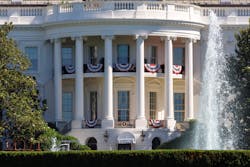White House Launches 'Clean Air in Buildings Challenge'
PRESS RELEASE
Washington DC -- March 17, 2022 -- Earlier this month, the Biden-Harris Administration released the National COVID-19 Preparedness Plan, a roadmap to move the country forward safely and continue to fight COVID-19 as Americans get back to their more normal routines. Today the Administration is launching the Clean Air in Buildings Challenge, a key component of the President’s Plan, that calls on all building owners and operators, schools, colleges and universities, and organizations of all kinds to adopt key strategies to improve indoor air quality in their buildings and reduce the spread of COVID-19.
The Clean Air in Buildings Challenge is a call to action for leaders and building owners and operators of all types to assess their indoor air quality and make ventilation and air filtration improvements to help keep occupants safe. As part of the Challenge, today, the Environmental Protection Agency (EPA) published a best practices guide for improving indoor air quality and reducing the risk of spreading dangerous airborne particles. This guide – developed in collaboration with the Department of Energy, Centers for Disease Control and Prevention, and other federal agencies – contains a set of clear recommendations organized into four groups:
- Create a clean indoor air action plan that assesses indoor air quality, plans for upgrades and improvements, and includes HVAC inspections and maintenance;
- Optimize fresh air ventilation by bringing in and circulating clean outdoor air indoors;
- Enhance air filtration and cleaning using the central HVAC system and in-room air cleaning devices;
- Engage the building community by communicating with building occupants to increase awareness, commitment, and participation.
Under each of these recommendation areas, EPA’s best practices guide lays out clear-cut actions building owners and operators can implement. The best practices guide is designed to serve as a menu of improvements to choose from. The guide includes quick steps that all organizations can take right away as a starting place, as well as resources to help plan for longer-term investments and improvements. The Biden Administration and Congress have provided hundreds of billions of dollars in federal funds that can be used in schools, public buildings, and other settings to improve indoor air quality.
The American Rescue Plan provided $350 billion for state and local governments, as well as $122 billion for schools, that can be used to support making ventilation and filtration upgrades. These American Rescue Plan dollars are being put to work in communities around the country in improving Heating, Ventilation, and Air Conditioning (HVAC) systems.
Funding within the State and Local Fiscal Recovery Fund program and the Elementary and Secondary School Education Relief program can be spent on inspection, testing, and maintenance of current ventilation systems; purchasing portable air filtration units, with HEPA air filters; purchasing MERV-13 (or higher) filters for HVAC system and air conditioners; purchasing fans; repairing windows and/or doors; servicing, upgrading, or replacing HVAC systems consistent with industry standards; and more.As detailed in the National COVID-19 Preparedness Plan, the Administration will continue to advance indoor air quality in buildings in additional ways, including:
- Supporting state, local, and Tribal governments as well as school districts to make ventilation improvements and upgrades using American Rescue Plan (ARP) and Bipartisan Infrastructure Law funds. The Administration will work closely with public sector partners like schools to provide guidance and technical assistance to make these improvements and connect them to agency resources on indoor air quality;
- Building public awareness around ventilation and filtration improvements to reduce disease spread in buildings. The Administration will build public awareness and communicate with the public on how ventilation and good indoor air quality are key factors in keeping Americans safe while inside buildings. The Administration will launch efforts to explain what good ventilation and air filtration look like as an important component of helping to reduce disease spread, and how buildings of any kind can pursue improvements to their ventilation and air filtration strategies;
- Highlighting actions taken by buildings to achieve clean, healthy air quality through a recognition program. While the Administration invites all buildings to take actions from the Clean Air in Buildings Challenge, the Administration will also foster ways to recognize steps taken by buildings to improve indoor air quality and protect their communities. Similar to how programs like LEED, Fitwel, and WELL recognize buildings for their environmental and health impacts, this new effort between the federal government and external experts will develop ways to recognize steps taken by building owners for the health and safety of their communities and their achievements in improving air filtration and ventilation systems to protect and promote public health;
- Catalyzing science and technology innovation to reduce indoor disease transmission. The Office of Science and Technology Policy (OSTP), in coordination with other partners through the Pandemic Innovation Task Force, is identifying opportunities to drive innovation and implementation of technologies to support clean indoor air in buildings and reduce disease transmission. OSTP will also host a series of public engagements to provide the latest science, tools, and best practices on improving indoor air quality.
##########
